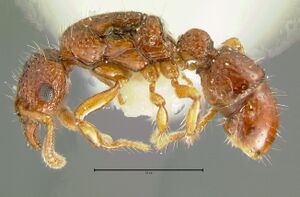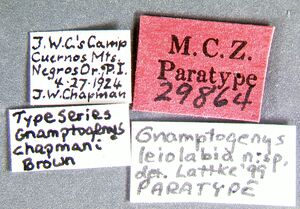Stictoponera leiolabia
| Stictoponera leiolabia | |
|---|---|

| |
| Scientific classification | |
| Kingdom: | Animalia |
| Phylum: | Arthropoda |
| Class: | Insecta |
| Order: | Hymenoptera |
| Family: | Formicidae |
| Subfamily: | Ectatomminae |
| Tribe: | Ectatommini |
| Genus: | Stictoponera |
| Species: | S. leiolabia |
| Binomial name | |
| Stictoponera leiolabia (Lattke, 2004) | |
The holotype series was collected from rotten logs in rainforest. Another collection was taken from a mixed dipterocarp forest.
Identification
Lattke (2004) - Specimens of this species were examined by Brown (1958) and were considered variants of Stictoponera chapmani. The paratype queen of S. chapmani is actually a female of Stictoponera leiolabia. S. chapmani is most easily separated from S. leiolabia by its clypeal structure, which is longitudinally strigulose, and the medially bluntly protruding lamella. S. chapmani also lacks the lateral ridges that extend anteriorly from the frontal lobes and define the sides of the clypeal lamella as in S. leiolabia. The predominantly smooth clypeus of S. leiolabia, with a median area bound by two crests, points at close affinities with Stictoponera biloba and Stictoponera hyalina. S. biloba and S. hyalina are considerably larger (HW > 0.80; WL > 1.00 mm) than S. leiolabia. The posterior median clypeal area in S. hyalina is much smoother, almost glabrous, while the clypeal ridges in S. biloba are much more protuberant and the metaxcoaxal tooth is peglike and not triangular.
Distribution
Latitudinal Distribution Pattern
Latitudinal Range: 5.833333492° to -3.633333°.
| North Temperate |
North Subtropical |
Tropical | South Subtropical |
South Temperate |
- Source: AntMaps
Distribution based on Regional Taxon Lists
Indo-Australian Region: Borneo, Indonesia, Malaysia (type locality), Philippines.
Distribution based on AntMaps
Distribution based on AntWeb specimens
Check data from AntWeb
Countries Occupied
| Number of countries occupied by this species based on AntWiki Regional Taxon Lists. In general, fewer countries occupied indicates a narrower range, while more countries indicates a more widespread species. |

|
Estimated Abundance
| Relative abundance based on number of AntMaps records per species (this species within the purple bar). Fewer records (to the left) indicates a less abundant/encountered species while more records (to the right) indicates more abundant/encountered species. |

|
Biology
Castes
- Queen
   
| |
| . | Owned by Museum of Comparative Zoology. |
Males are unknown.
Nomenclature
The following information is derived from Barry Bolton's Online Catalogue of the Ants of the World.
- leiolabia. Gnamptogenys leiolabia Lattke, 2004: 206, fig. 56 (w.q.) BORNEO (East Malaysia: Sabah, Sarawak), PHILIPPINES (Negros I.).
- Type-material: holotype worker, 2 paratype workers, 1 paratype queen.
- Type-locality: holotype Malaysia: Sabah, Sebuga Forest Reserve, nr Sandakan, 9.vi.1968, 68.371, ANIC ants vial 6.216 (R.W. Taylor); paratype with same data.
- Type-depositories: ANIC (holotype); ANIC, MCZC (paratypes).
- Combination in Stictoponera: Camacho, Franco, Branstetter, et al. 2022: 12.
- Status as species: Pfeiffer, et al. 2011: 35; Camacho, Franco, Branstetter, et al. 2022: 12.
- Distribution: Malaysia (Sabah, Sarawak), Philippines (Negros).
Unless otherwise noted the text for the remainder of this section is reported from the publication that includes the original description.
Scapes when laid back do not reach posterior cephalic margin by at least one apical width; clypeus and mandibular dorsum mostly smooth, almost glabrous; clypeus delimited laterally by low carinae that extend from ends of clypeal lamella; occipital lamella short in lateral view, with bluntly angular anterior and posterior ends.
Type Material
- Holotype, worker, Sebuga For. Res. near Sandakan, Sabah, Malaysia, Taylor,R.W., ANIC32-017684, Australian National Insect Collection.
Description
Worker
Metrics. [Holotype] Paratypes (n = 3): HL [0.66] 0.63-0.64, HW [0.46] 0.45-0.47, ML [0.26] 0.26-0.28, SL [0.37] 0.36-0.39, ED [0.14] 0.13-0.14, WL [0.84] 0.81-0.84 mm. CI [0.70] 0.71-0.72, SI [0.80] 0.77-0.86, MI [0.57] 0.55-0.62, OI [0.31] 0.28-0.32. Head with subparallel sides in frontal view, occipital corner sharply curved, not angular; frons mostly smooth with longitudinal strigulae; foveolae on frons denser laterally with some smooth patches, especially just dorsad of eye; clypeus mostly smooth down to lamella, with median area surrounded by two longitudinal crests that extend from next to anterior end of frontal lobes to lateral ends of clypeal lamella, each crest with convexity posterad of lamella, anterior margin of lamella straight; frontal lobe convex, longitudinally strigulose dorsally; mandibular dorsum mostly smooth with scattered punctae, longitudinal strigulae sometimes present basally, external margin relatively straight; head with dorsal margin broadly convex in lateral view, except for small elevation at posterior end of frontal lobe and rounded clypeal angle; occipital lamella brief, convex, with bluntly angular anterior and posterior ends.
Ventral pronotal margin convex, laterally mostly smooth with sparse foveolae, foveolae denser dorsally, anteroventral margin raised, not bordered by deep sulcus; mesopleuron mostly smooth, anepisternum more foveolate than katepisternum; metapleuron mostly smooth with longitudinal strigulae ventrad; mesosoma with broadly convex dorsal margin in lateral view, forming blunt angle with propodeal declivity. Petiolar node broadly convex dorsally in lateral view, anterior shelf very brief, inclined, forming fine notch with node, posterior shelf present; subpetiolar process subquadrate; postpetiolar ventral margin straight to broadly convex just posterad of process in lateral view, postpetiolar tergite anterolaterally with large foveolae becoming shallower and smaller posterad, rest of postpetiole smooth with scattered punctae; fourth abdominal tergite smooth with scattered punctulae. Fore coxa smooth in lateral view. Dorsum of thorax and abdominal segments 1 4 with scattered erect to subdecumbent hairs. Body ferruginous brown, legs and antennae ferruginous.
Queen
Metrics (n = 2): HL 0.69, 0.71; HW 0.52, 0.54; ML 0.30, 0.32; SL 0.41, 0.43; ED 0.17, 0.19; WL 1.00, 1.02 mm. CI 0.75, 0.76; SI 0.79, 0.80; MI 0.57, 0.59; OI 0.32, 0.36. The first queen is from the same series as the holotype; the second female is from the MCZC. Besides inherent caste characters, substantial differences from workers are denser foveolae and punctae on frons; elongated, smoother anepisternum; metapleuron with narrower smooth area; petiolar node more convex in lateral view.
Type Material
Holotype worker. Malaysia, Sabah, Sebuga Forest Reserve near Sandakan rainforest, 9-vi-1968, R.W. Taylor 68.371. ANIC ants vial 6.216. Deposited in ANIC. Paratypes. One worker and queen deposited in ANIC, 1 worker in MCZC from same nest as holotype.
Etymology
The species name is derived from a conjugation of the Greek leios, meaning “smooth,” and the Latin labium (n.), “lip.”
References
- Brown, W. L., Jr. 1958g. Contributions toward a reclassification of the Formicidae. II. Tribe Ectatommini (Hymenoptera). Bulletin of the Museum of Comparative Zoology 118: 173-362.
- Camacho, G.P., Franco, W., Branstetter, M.G., Pie, M.R., Longino, J.T., Schultz, T.R., Feitosa, R.M. 2022. UCE phylogenomics resolves major relationships among Ectaheteromorph ants (Hymenoptera: Formicidae: Ectatomminae, Heteroponerinae): A new classification for the subfamilies and the description of a new genus. Insect Systematics and Diversity 6(1): 5; 1–20 (doi:10.1093/isd/ixab026).
- Lattke, J. E. 2004. A Taxonomic Revision and Phylogenetic Analysis of the Ant Genus Gnamptogenys Roger in Southeast Asia and Australasia (Hymenoptera: Formicidae: Ponerinae). University of California Publications in Entomology 122: 1-266 (page 206, fig. 56 worker, queen described)
References based on Global Ant Biodiversity Informatics
- Asfiya W., L. Lach, J. D. Majer, B. Heterick, and R. K. Didham. 2015. Intensive agroforestry practices negatively affect ant (Hymenoptera: Formicidae) diversity and composition in southeast Sulawesi, Indonesia. Asian Myrmecology 7: 87-104.
- CSIRO Collection
- Lattke J. E. 2004. A taxonomic revision and phylogenetic analysis of the ant genus Gnamptogenys Roger in Southeast Asia and Australasia (Hymenoptera: Formicidae: Ponerinae). University of California Publications in Entomology 122: 1-266.
- Lattke, J.E. 2004. A taxonomic revision and phylogenetic analysis of the ant Gnamptogenys Roger in Southeast Asia and Australasia (Hymenoptera: Formicidae: Ponerinae). University of California Publications in Entomology 122: 1-266
- Pfeiffer M.; Mezger, D.; Hosoishi, S.; Bakhtiar, E. Y.; Kohout, R. J. 2011. The Formicidae of Borneo (Insecta: Hymenoptera): a preliminary species list. Asian Myrmecology 4:9-58
- Woodcock P., D. P. Edwards, T. M. Fayle, R. J. Newton, C. Vun Khen, S. H. Bottrell, and K. C. Hamer. 2011. The conservation value of South East Asia's highly degraded forests: evidence from leaf-litter ants. Phil. Trans. R. Soc. B. 366: 3256-3264.


